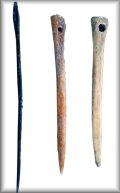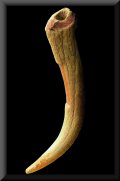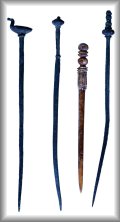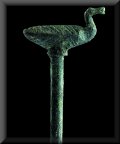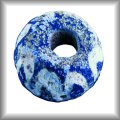



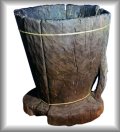


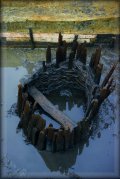









Józef Bednarczyk
Major changes began to take place in the existing cultural patterns of society across large areas of Central and Northern Europe in the final centuries bc. These changes were inspired by influences reaching this area from the Celtic world and led to a major upheaval in existing social and economic structures. All aspects of culture were affected, from technology to symbolism, leading to their gradual unification. Having reached as far as the Danube and the Rhine, the Romans began to secure their frontiers with a series of fortifications known as the Roman limes. These divided contemporary Europe into two zones: the civilized world and that which lay beyond its limits - referred to by the Romans as Barbaricum. The limes did not, however, constitute an ‘iron curtain’. The Danubian and Rhineland provinces which lay on the other side of this frontier acted as cultural outposts in barbarian Europe. This political order lasted some four hundred years, up until the Migration Period initiated by the emergence of the Huns.
The Region of Kuiavia was one of the major settlement centres at this time and played a significant cultural and economic role in Barbaricum. Archaeological work carried out here as part of the gas pipeline project surrendered a fascinating wealth of information, some of it quite unique, about the everyday life of local communities.
Settlement sites consisted of several domestic dwellings, numbering no more than twenty. These houses varied in their construction, shapes and sizes. The most popular type were shallow sunken-floored grübenhauser, built to a rectangular groundplan measuring on average 3-5 x 4-7 m and covering a surface area of 20-30 m2. In terms of their size, they were far removed from today’s standards. The walls of these houses were made of timber balks in-filled with clay, whilst their roofs were thatched with either straw or rush. Heating was provided by a centrally located hearth, which also served for cooking meals. Other settlement features included wells, kilns, hearths, byres, grain stores, storage pits and miscellaneous buildings. These were positioned either directly next to the dwellings or in a clearly demarcated area.
Crop cultivation and animal husbandry were the mainstays of the local economy. The Roman historian Tacitus wrote in his Germania of the political and social relations in barbarian Europe: ‘... this land ... is rich in grain ... and has abundant livestock ...’. Confirmation of this fact was gained from palaeobotanical samples taken at a number of settlement sites excavated along the gas pipeline route (those found at Żegotki, Sławsko Wielkie and Głojkowo). Grains of wheat, barley, rye and oats were identified in the analysed material. At Bożejowice, Sławsko and Głojkowo flour was made using rotary grinders adopted from Celtic societies, whilst a site at Karczyn provided evidence of grains having been cracked with the use of a heavy wooden mortar. All species of domesticated animal known at the time were reared in this region: cattle, sheep, goat, pig, horse and fowl. Analysis of bones constituting food debris indicated that cattle predominated in these herds, followed by smaller ruminants, pig and horse. The negligible proportion of animal remains representing wild species suggests that hunting and fishing played only a marginal role in these societies subsistence strategies.
Each settlement was self-sufficient to a large degree. Individual households made most of their own tools and items of everyday use. This was primarily true of pottery which was produced from the readily available local moraine clay. These vessels served a multitude of purposes, equipping kitchens and pantries, as well as being used as tablewares. They were also utilized as packaging for a variety goods destined which needed to be stored or transported.
Textile production and bone- and antler-working were the industries most fully represented in the find assemblages recovered, which also included evidence of metalworking, stoneworking and woodworking.
A particularly valuable discovery relating to the manufacture of textiles was made at Karczyn. At the edge of this second/third-century ad settlement, a facility (unique on a European scale) comprising equipment used in the initial stages of preparing linen and hemp was found situated within a shallow body of water. Here a series of large wooden vats had been dug into the ground, well below the water table. Bundles of linen or hemp were stacked inside them in layers and left to soak for several days in order to separate the fibres from their tough stems. The last, excellently preserved, bundles lying at the bottom of these vats were recovered during the course of excavation 1700 years later! This was the first time that archaeologists were able to record this initial stage of plant fibre processing; the sum of previous knowledge on this subject having stemmed from indirect evidence in the form of much later ethnographic analogies and written sources. Archaeological materials from the neighbouring settlement at Głojkowo attested equally well to the subsequent phases of linen processing. Numerous spindle whorls for spinning flax into yarn were found here, as were sets of loom weights for stretching the warp on the frame of a loom. The presence of spindle whorls and loom weights in almost every house (not only at the Głojkowie settlement) points to textile production having been the most commonly practised of all domestic crafts.
In contrast, antler-working is a craft which requires professional skills and a specialized tool kit. A workshop producing combs and possibly also cases was revealed at Sławsko Wielkie. The workshop had - in unexplained circumstances - been destroyed by fire. This resulted in a vast quantity of artefacts having survived there, undisturbed. These amounted to a total of over 10,000 pieces, comprising raw material, pre-prepared forms and production waste. Every stage of manufacture can be traced here: the trimming of antlers into workable blocks, which are then divided into plates from which the teeth and the case are prepared, then smoothed, fitted together and, by careful cutting, provided with a set of teeth to produce a comb.
Exchange transactions played an important role in the lives of the local populations. The trade route known as the amber trail led across the region of Kuiavia. This was one of the most important ancient communication tracts, linking the Baltic coast with the Mediterranean world. Trade in amber intensified greatly towards the end of the second-third century ad. During this period communities inhabiting the Kuiavia region became the intermediaries in its distribution. Having been brought here from the Baltic coast, the amber was then processed at local workshops, producing mostly beads for use as exchange goods. Three amber-working sites of this type were found during the gas pipeline excavations (at Głojkowo and Kuczkowo). These amber beads were exchanged for imports such as Greek and Roman coins, glassware, bronze vessels, pottery, ornaments and other luxury goods.
These contacts are also perceptible in the sphere of cult practices, as represented by the sanctuary at Sławsko Wielkie. This complex is centred around a small temple - a rectangular building measuring 5-6 m, its floor consisting of several layers of compacted or fired clay, whilst its roof rests on a colonnade of wooden posts. At the very centre of the temple itself stood a round altar. Distributed around the temple were sacrificial animal burials (of dog, goat, sheep and pig), stones of specific shape, pottery discs, and an isolated sacrificial pit containing a human skeleton. This entire area constituted the sacred ground (sacrum), which was fenced off from its generally accessible surroundings (profanum). Four temples of this kind (which had probably been used in succession) were found at the settlement site. The origins of these temples are rooted in the Hellenistic world. They appeared in the Kuiavia region during the second century bc - in a much diminished form - via the Celtic cultural realm. Having reached these territories the temples were adapted to include a variety of elements.
BACK
